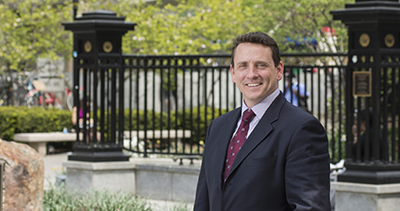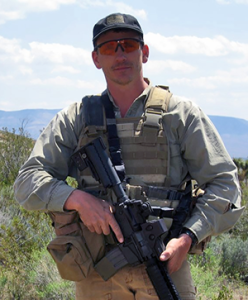Jared Ross, M.B.A. ’03, B.S. ’01, adjunct instructor of clinical research and leadership, talks transitions between military and civilian protocols and life
As a child, Jared Ross, M.B.A. ’03, B.S. ’01, dreamed of being a Green Beret in the United States Army Special Forces. That dream stayed abstract until 1990, when Ross was a junior at the University of Maryland. The Greenbelt, Maryland, native felt that the start of Operation Desert Shield would lead to a long-lasting conflict — and he wanted to be a part of it. “That’s how it started,” he says. Twenty-six years later, Ross, who retired from the U.S. armed forces on Nov. 1, 2014, has bridged the gap between military and civilian life, and now, as an adjunct instructor of clinical research and leadership at the GW School of Medicine and Health Sciences (SMHS), he’s in a position to help the next generation.

Q: You’ve spent most of your career in the military. How did you make the transition to GW?
A: When I was in the middle of my career in the military, there weren’t many options for four-year degrees being offered by universities with any kind of clout. The ones that were, you had to have the ability to do some kind of in-residence work, and I couldn’t do that at all. However, GW had started this program with some fine collaboration with the Navy that initially was being offered only to independent duty corpsmen. Then they opened it up to medics who were trained in the Special Forces, both SEALs and Green Berets. I jumped on that because it was all online; it was one of the first really high-quality bachelor’s degrees you could get online. I had not finished my degree, so I was looking for that opportunity to finish.
Toward the end of my military career, I decided that I wanted to increase the amount of civilian education I had before I was going to tackle finding a job outside the military. The first thing I did was go to the general management program at Harvard, which was a fantastic program, but really looked at the business world from a 200,000-foot level, managing global organizations. I felt like I needed to fill in the gaps with some particular skills with regard to finance and accounting, while also looking at a more organic level of operating businesses. So I chose the program here at GW. That’s part of how I ended up as an adjunct faculty member: a long relationship as a student.
"GW has a strong reputation in the military. George Washington is such a good school, and to be able to [attend the school is such] an opportunity." - Jared Ross, M.B.A. ’03, B.S. ’01
On the opposite side of that, one of the things I did for years was instruct tactical combat casualty care (TCCC), or military first responder techniques, and a number of the people involved in that were affiliated with the health sciences and emergency medicine here at GW. Those two things finally intersected last summer, and I was given the opportunity to come on as adjunct faculty for the program.

Q: Can you tell me more about TCCC?
A: Tactical combat casualty care is actually a military term for a [kind of] protocol. There’s a really interesting, long history to how that started. TCCC was one of the positive things that sprang out of the Battle of Mogadishu in 1993, because that was the first time we just had massive amounts of data, in both eyewitness accounts and recorded radio and video transmissions. They were able to — almost minute-by-minute, in certain cases — document what was going on with all these types of injuries on the ground. So we got a really good look at some of the previous advance trauma life support protocols that we were teaching our special operations medics and realized what wasn’t working and what would work. Then there’s this whole long history to get these bureaucracies to agree upon what was the right thing to do. I was there for the development of all that and watched it progress.
Prior to 9/11, these protocols were adopted; following 9/11 and the conflicts in Afghanistan and Iraq, the need to train people under these practices just exploded, both in the military world and in federal agencies that were putting people out in the combat zone, in harm’s way. These really didn’t start to cross over into actual civilian emergency medicine until recently, the last few years, and there’s still a lot of resistance to adoption because some of the protocols are considered to be far too aggressive to be implemented without a doctor’s supervision. There’s a lot of argument back and forth about whether we can do the things we’re allowed to do as military providers versus civilian providers.
When that was all going on, I had a number of friends who had started businesses and were asking me to teach, so I taught a variety of students, from both the provider side and the non-medical-provider operator side.
Q: Can what the military does translate to how non-military personnel tackle problems?
A: There’s a whole lot more that the military does that could be adopted on the civilian side in terms of managing large-scale issues. However, if you step out of the combat zone and look at everything from an active shooter situation to a natural disaster, a lot of what the military does every day and is resourced to do is very difficult to do on the civilian side, because of the need for coordination between multiple different agencies, and the lack of a clear chain of command, and other issues that go on and on.
Oftentimes, the worst things happen in the places least prepared to deal with them — for example, the earthquake in Haiti. Tons and tons of support was standing ready, but there was no easy way to actually get it to the point where it was most needed because of the lack of internal infrastructure, what was even left of it. Add to that a dysfunctional civilian authority in place there, leaving billions of dollars of resources sitting on ships and in shipyards, unable to reach the people who most needed it. The military played a big role there. In looking at what we do, I think there’s also some room for growth on the civilian side for managing these situations as well.
Q: You’re teaching courses in both the Clinical Management and Leadership Program and the Health Sciences Laboratory Technology Certificate Program, which is through the Military Affiliated Programs; do you think GW helps to act as a gateway for those re-entering civilian life after a career in the military?
A: GW has a strong reputation in the military. George Washington is such a good school, and to be able to [attend the school is such] an opportunity. In the past, the types of institutions drawing a lot of military were ones without ... the kind of academic rigor you see from the higher-tier universities. GW, more than anyplace else I’m aware of, has really opened up to the community, and it’s more user-friendly; there’s a strong Veterans Affairs office here, and the reputation is growing.
GW SMHS has had a long-standing relationship with the United States Navy and the United States Army, offering contract degree programs in a variety of health sciences fields to active-duty service members, such as the Certificate in Health Sciences Laboratory Technology, which is offered through an interservice contract with the Medical Education and Training Campus at Fort Sam Houston. The Military Affiliated Programs include several online degree completion programs for active-duty and retired services members. The Associate in Science (A.S.) degree in health sciences laboratory technology allows for the development of skills ideal for educational and military advancement. The Clinical Health Sciences, Health Intervention and Disaster Response, and Emergency Medical Services Management Programs are bachelor’s degree completion pathways ideal for soldiers, sailors, and airmen coming from the special forces and medical occupations.



